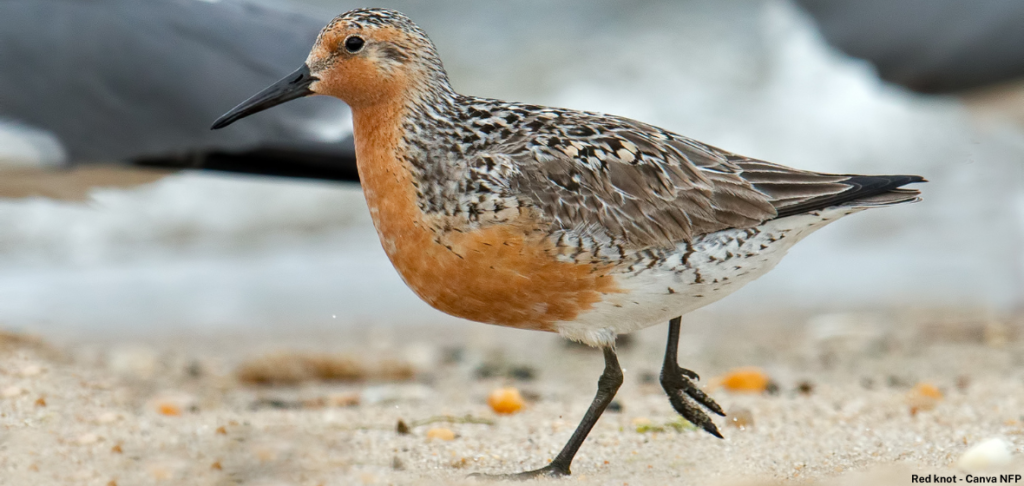
18 October 2024
As migratory birds arrive in Australia this spring, they may bring a deadly virus—avian influenza H5N1. While Australia remains free from this highly pathogenic strain, the arrival of infected birds is a real possibility. Here’s what you need to know and how you can help protect our unique species from this threat.
What is H5N1 and why is it a concern?
H5N1, a highly pathogenic avian influenza (HPAI), is a viral disease affecting wild birds and poultry. This strain has devastated bird populations globally in the last two years, killing millions of wild birds and thousands of mammals. While Australia has escaped the outbreak, experts predict that the virus could arrive with migratory shorebirds and seabirds from the Northern Hemisphere.
This poses a serious threat to Australian wildlife, particularly as one in six bird species in Australia is already facing the threat of extinction. If H5N1 spreads here, it could lead to catastrophic losses of native birds, further endangering our threatened species.
Federal Environment Minister Tanya Plibersek said, “I am particularly concerned about the potential impact on species already at risk of extinction and not well placed to cope with significant mortalities. This includes marine mammals such as the endangered Australian sea lion and sea birds like the Christmas Island frigatebird, which has only one breeding site.”
How could H5N1 affect Australian wildlife?
In Australia, migratory shorebirds, seabirds, and birds of prey are especially vulnerable. An outbreak among these birds could significantly impact populations that are already under pressure from habitat loss, climate change, and human activity.
There is a concern that the virus could affect species like black swans (Cygnus atatrus), which gather in large flocks on wetlands. Black swans are highly social, and if even a few birds in a population become infected, the virus could spread quickly, leading to high mortality rates.
Marine mammals, such as Australian sea lions (Neophoca cinerea) are also at risk if the H5N1 virus spreads in coastal areas. Sea lions could become infected through contact with sick birds or contaminated water, leading to potential outbreaks within colonies. The virus has already impacted mammals worldwide, including seals, tigers, raccoons, minks, and foxes.
What is Australia doing to prepare?
On 14 October 2024, the Australian Government announced a $95 million integrated package to further prepare and protect the nation against the threat of the HPAI H5N1 strain.
The package aims to strengthen surveillance, preparedness and response capability, reducing the impact of HPAI H5N1 on Australian agriculture, environment and human health.
Federal Environment Minister Tanya Plibersek has also called a special meeting with state and territory environment ministers scheduled for 18 October 2024 to discuss strategies for preventing the virus from spreading to Australia.
Recognising the signs of H5N1 in birds
To help protect wildlife, it’s crucial to know the signs of bird flu. If you notice any of the following symptoms in a bird, report it immediately:
• lack of coordination, tremors, or swimming in circles
• twisted neck or abnormal posture
• inability to stand or fly
• difficulty breathing
• coughing/sneezing
• swelling around the head, neck, and eyes
• cloudy or discoloured eyes
• sudden death, especially in clusters of five or more wild birds.
What to do if you find a sick or dead bird
If you come across a sick or dead bird, it’s important to act quickly while avoiding direct contact.
- Avoid handling the bird or its environment. Keep pets away as well.
- Record the location, date, and any visible symptoms. Take photos or video, if possible, without approaching the bird.
- Report the sighting by calling the Emergency Animal Disease Hotline at 1800 675 888.
Other steps you can take to help prevent the spread of H5N1 include cleaning your footwear before and after visiting parks or reserves, avoiding feeding birds to reduce the chance of disease transmission, and keeping dogs leashed on beaches where birds are present.
“While the threat of H5N1 is serious, by staying informed and ready to report any unusual wildlife illness, we can all play a part in protecting Queensland’s wildlife from this deadly virus,” emphasises Wildlife Queensland Project Manager Matt Cecil.
Bibliography and further information
1. Avian Influenza – BirdLife Australia
2. https://www.agriculture.gov.au/biosecurity-trade/pests-diseases-weeds/animal/avian-influenza
4. H7 high pathogenicity avian influenza | Outbreak
5. The other pandemic – protecting Australian wildlife from the avian flu – Invasive Species Council
